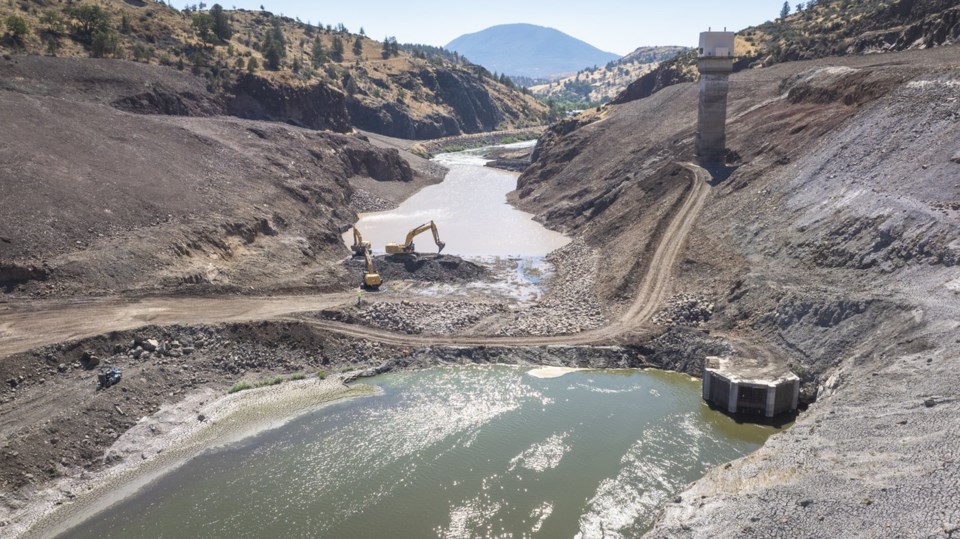Workers are breaching the final dams on a key section of the Klamath River on Wednesday, clearing the way for salmon to swim freely through a major watershed near the California-Oregon border for the first time in more than a century as the in U.S. history nears completion.
Crews used excavators to remove rock dams that have been diverting water upstream of two , Iron Gate and Copco No. 1, both of which were already almost completely removed. The work will allow the river to flow freely in its historic channel, giving salmon a passageway to key swaths of habitat just in time for the fall Chinook, or king salmon, spawning season.
“Our sacred duty to our children, our ancestors, and for ourselves, is to take care of the river, and today’s events represent a fulfillment of that obligation," Frankie Myers, vice chairman for the Yurok Tribe, which has spent decades fighting to remove the dams and restore the river, said in a statement.
The demolition comes about a month before removal of four towering dams on the Klamath was set to be completed to let rivers return to their natural flow and to restore ecosystems for fish and other wildlife.
As of February, more than 2,000 dams had been removed in the U.S., the majority in the last 25 years, according to the advocacy group American Rivers. Among them were dams on Washington state’s Elwha River, which flows out of Olympic National Park into the Strait of Juan de Fuca, and Condit Dam on the White Salmon River, a tributary of the Columbia.
“I am excited to move into the restoration phase of the Klamath River," Russell ‘Buster’ Attebery, chairman of the Karuk Tribe, said in a statement. "Restoring hundreds of miles of spawning grounds and improving water quality will help support the return of our salmon, a healthy, sustainable food source for several Tribal Nations."
Salmon are culturally and spiritually significant to the tribe, along with others in the region.
The Klamath was once known as the third-largest salmon-producing river on the West Coast. But after power company PacifiCorp built the dams to generate electricity between 1918 and 1962, the structures halted the natural flow of the river and disrupted the lifecycle of the region’s salmon, which spend most of their life in the Pacific Ocean but return up their natal rivers to spawn.
The fish population then dwindled dramatically. In 2002, a bacterial outbreak caused by low water and warm temperatures killed more than 34,000 fish, mostly Chinook salmon. That jumpstarted decades of advocacy from tribes and environmental groups, culminating in 2022 when federal regulators .
Since then, the smallest of the four dams, known as Copco No. 2, has been removed. Crews also drained the reservoirs of the other three dams and started removing those structures in March.
Along the Klamath, the dam removals won’t be a major hit to the power supply. At full capacity, they produced less than 2% of PacifiCorp’s energy — enough to power about 70,000 homes. Hydroelectric power produced by dams is considered a clean, renewable source of energy, but many larger dams in the U.S. West have become a target for environmental groups and tribes because of the harm they cause to fish and river ecosystems.
The project was expected to cost about $500 million — paid for by taxpayers and PacifiCorps ratepayers.
But it’s unclear how quickly salmon will return to their historical habitats and the river will heal. There have already been reports of salmon at the mouth of the river, starting their river journey. Michael Belchik, senior water policy analyst for the Yurok Tribe, said he is hopeful they’ll get past the Iron Gate dam soon.
“I think we’re going to have some early successes,” he said. “I’m pretty confident we’ll see some fish going above the dam. If not this year, then for sure next year.”
There are two other Klamath dams farther upstream, but they are smaller and allow salmon to pass via fish ladders — a series of pools that fish can leap through to get past a dam.
Mark Bransom, chief executive of the Klamath River Renewal Corporation, the nonprofit entity created to oversee the project, noted that it took about a decade for the Lower Elwha Klallam Tribe to start fishing again after the removal of the Elwha dams.
“I don’t know if anybody knows with any certainty what it means for the return of fish,” he said. “It’ll take some time. You can’t undo 100 years’ worth of damage and impacts to a river system overnight.”
Hallie Golden, The Associated Press



